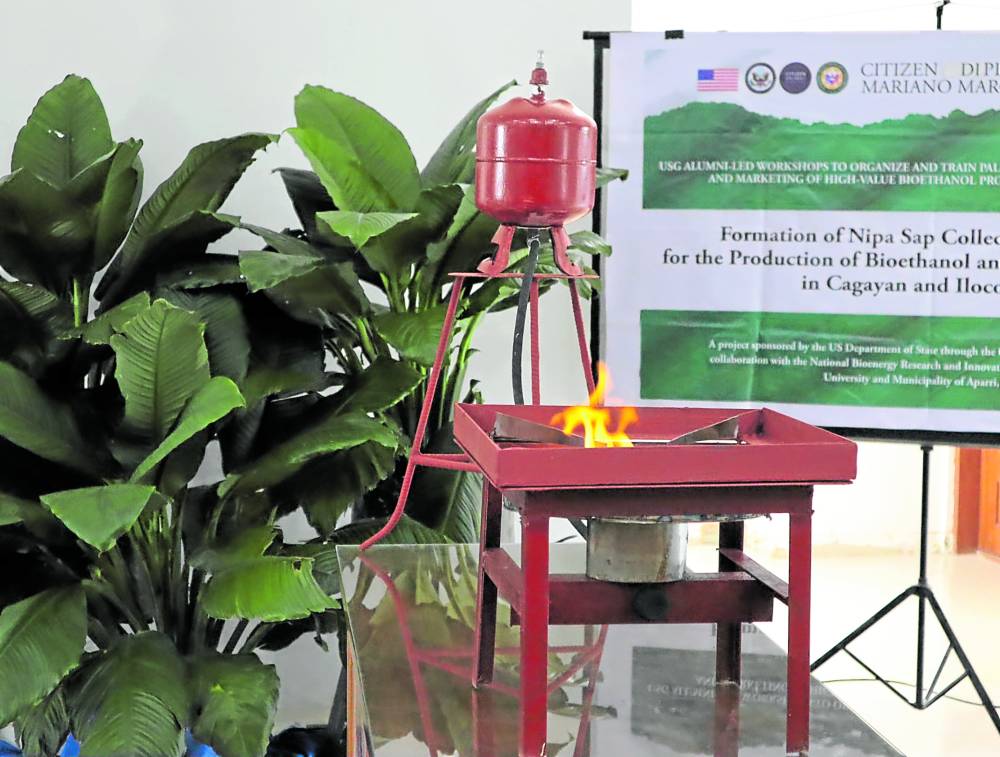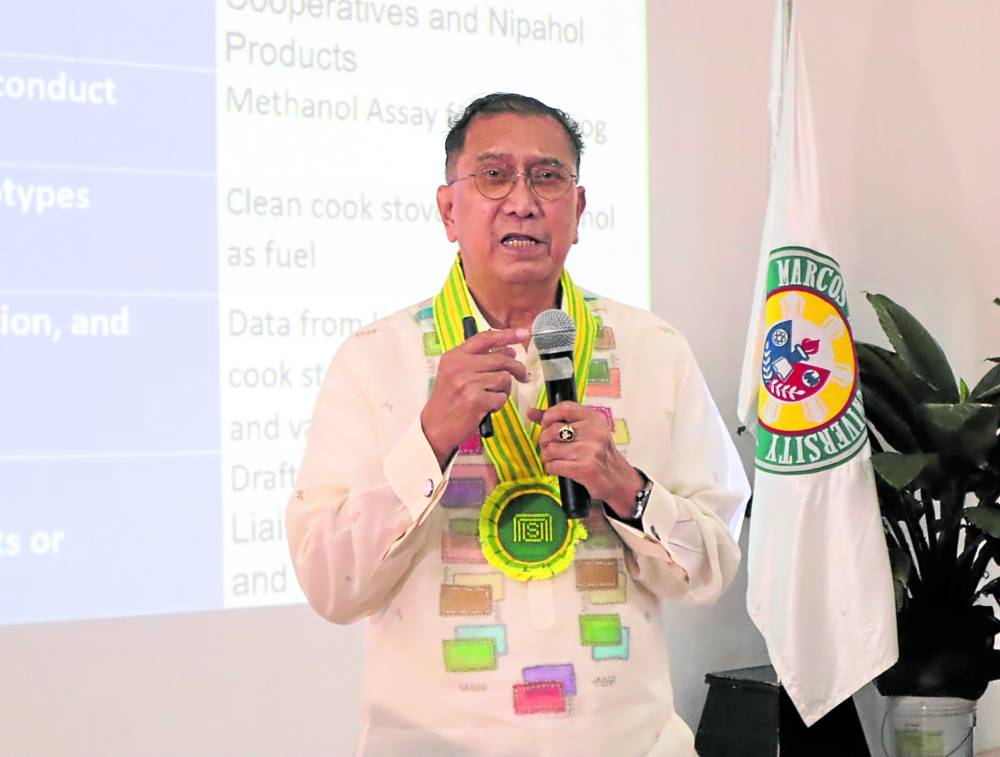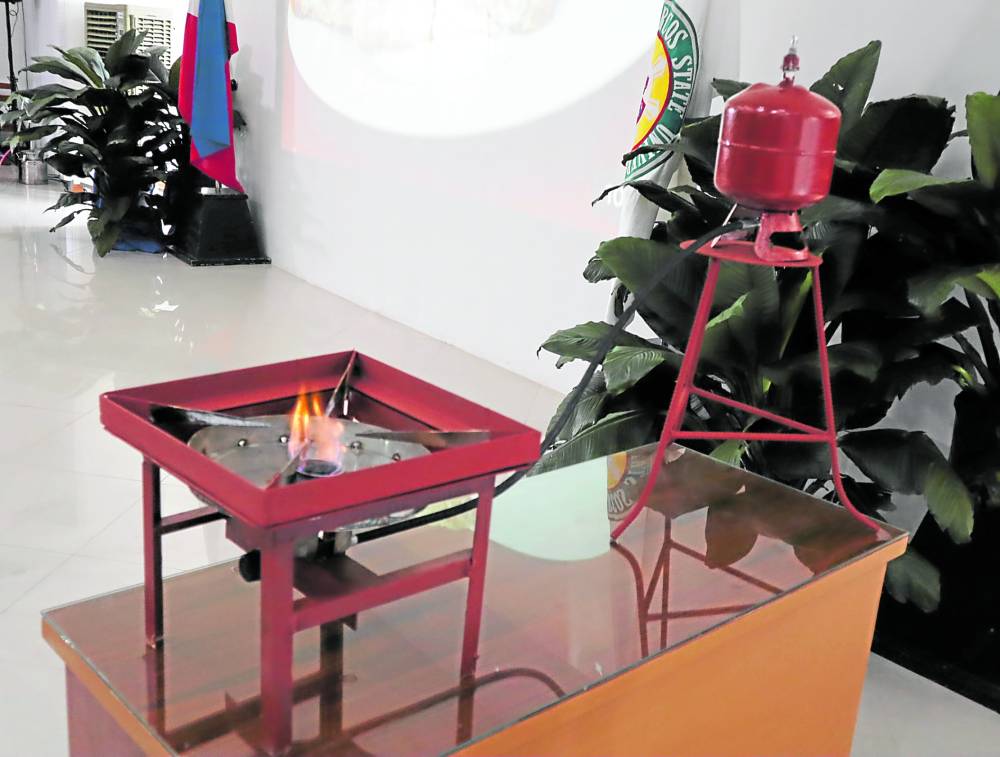Nipa sap eyed as green alternative to LPG

PROUDLY HOMEGROWN A team of scientists at the Mariano Marcos State University led by Fiorello Abenes (left) has extracted ethanol from nipa sap, using a stove prototype (right), with the aim of providing cleaner gas alternatives. —PHOTOS FROM THE DEPARTMENT OF SCIENCE AND TECHNOLOGY
For years now, Filipino scientist Fiorello Abenes has been studying the tropical nipa plant (Nypa fruticans) that grows mainly along the Philippines’ meandering coastlines. Humble yet surprisingly nimble, it can transform into many things: its leaves, a hut; its sugar-rich sap, into ethanol.
Now, he and his team at the Mariano Marcos State University (MMSU) have found a way to use nipa ethanol, or “nipahol,” as an alternative cooking fuel to liquefied petroleum gas (LPG).
Under the Department of Science and Technology’s Balik Scientist program—under which he counted among its first Balik Scientists in the 1970s—Abenes and his team have developed a prototype that uses gravity instead of pressurized gas to “feed” nipahol to a burner. When scaled up, this project can help provide jobs in coastal communities and even help do away “dirty cooking,” especially in the country’s rural areas, where many still rely on biomass, kerosene and coal.
Vehicle fuel
But beyond cleaner cooking fuel, Abenes is targeting something more radical—using nipahol as a cheap gasoline additive for cars.
“Of course, it’s still a good thing to pursue (nipahol as cooking fuel). We are still helping the environment, and we would save a lot of lives,” he told the Inquirer. “But the better use for nipa sap is to adapt its ethanol as a suitable gasoline additive and help drive gas prices down.”
In fact, he and his team have known for quite some time that it can be done. For years now, the MMSU has been distilling nipa sap in their own facilities using a four-hour process called reflux distillation, which extracts 95 percent hydrous ethanol from the sap.
The distilleries cost P500,000, and so far they’ve produced 3,000 liters of ethanol. Some were repurposed into disinfectants used in northern Luzon during the pandemic, and also for a nipahol stove prototype.
Right now, he said, they need more funding to be able to turn nipahol into pressurized gas like LPG and to commercialize it eventually.
But what Abenes is ultimately hoping for is a green light from the Department of Energy to test nipahol as a renewable fuel.
This is because ethanol can be used as a vehicle fuel by itself (E100), blended with gasoline (E85), or as a gasoline octane enhancer (10 percent concentration).

PROUDLY HOMEGROWN A team of scientists at the Mariano Marcos State University led by Fiorello Abenes (left) has extracted ethanol from nipa sap, using a stove prototype (right), with the aim of providing cleaner gas alternatives. —PHOTOS FROM THE DEPARTMENT OF SCIENCE AND TECHNOLOGY
‘Satisfactory substitute’
The 2006 Biofuels Act mandates the use of 5 percent ethanol in gasoline by 2009 and 10 percent in 2011. However, the law also requires that the ethanol used be 99.6 percent anhydrous, or without water.
Abenes, however, disagrees with that high threshold, as 95 percent hydrous ethanol is the maximum that can be extracted from indigenous sources like nipa, sweet sorghum and coconut. Studies abroad, for example, have shown that using hydrous ethanol can be just as efficient and economical for cars.
In 2017, a team of MMSU scientists led by its president, Shirley Agrupis, as well as Nathaniel Ericson Mateo, James Paul Madrigal and Marilou Lucas tested out that formula on a brand-new Kia car and a Japanese motorbike.
For these test runs, they found that hydrous ethanol blends provide more power and better fuel economy compared with anhydrous ethanol and neat gasoline.
“Based on these studies, the study concludes that hydrous ethanol is a satisfactory substitute to anhydrous ethanol both as oxygenate and as gasohol fuel,” the authors said.
“Considering the production cost difference, a case can be made that the Philippines should consider transitioning to hydrous ethanol as oxygenate and fuel in the future,” they added.

Beyond mere cooking fuel, a team of scientists at the Mariano Marcos State University are hoping to use ethanol extracted from nipa sap into cleaner gas alternatives. —DOST
‘Harvest’
This is where nipahol comes in, Abenes said. Compared with sugarcane and coconut, nipa is the most efficient source of ethanol “because the sap you extract from it is already fermented, and there is no investment because they grow in coastal areas.”
At present, there are around 38,000 hectares of nipa across the country, Abenes said. “You do not have to plant it, you do not have to cultivate it, you can just harvest and harvest 100 days a year for one plant. Each harvest can extract one and a half liter,” he added.
Even the distillery facilities at MMSU are “so sophisticated and yet so simple,” he added. “If we can only give a chance to this technology, we can create so many jobs, as 62 percent of our people live in coastal areas… It’s a big income earner but first we have to find the market to do it.”
He estimated that their current stock of nipahol can be mixed initially to 60,000 liters of gasoline. “All we need is a gasoline station and money to do it, and we can provide a side-by-side comparison on cars and tricycles.”
“It’s so ironic that we’re getting all this publicity for a stove [when] we can demonstrate that this can be used as an alternative source of fuel,” Abenes said.
“We have long been finished with the research and all we need is the chance to try it out.” INQ
RELATED STORIES
PhilRice facility uses nipa to power up towns